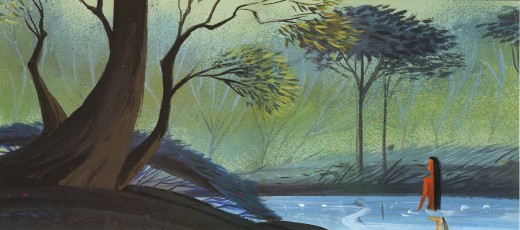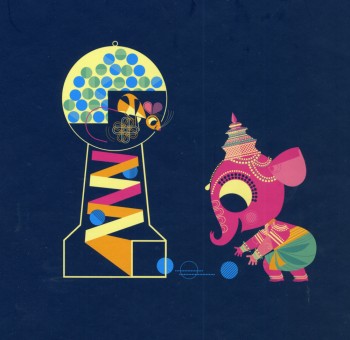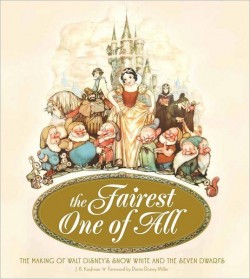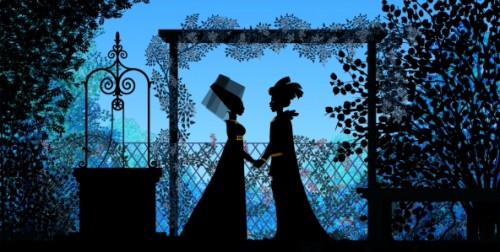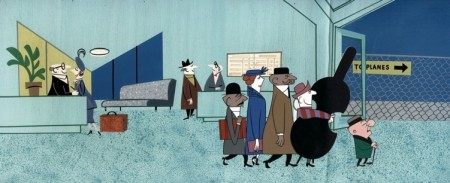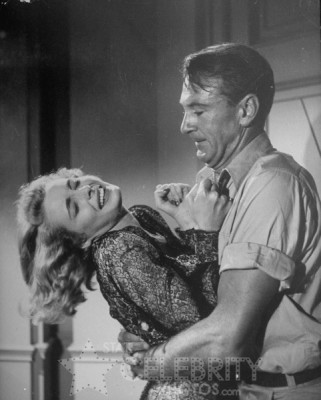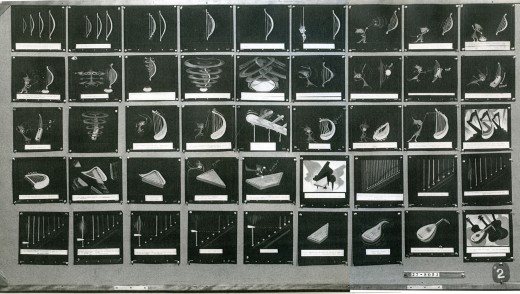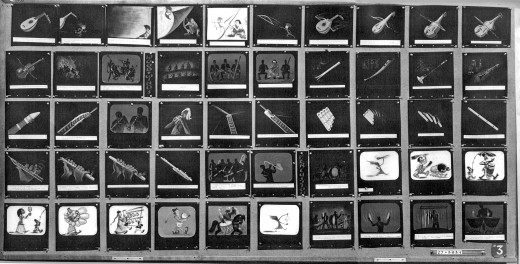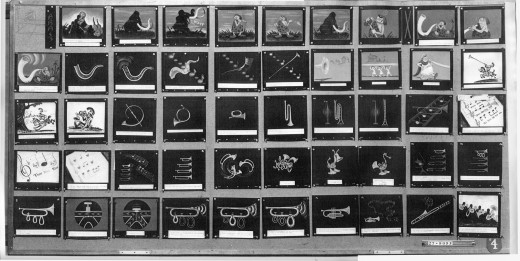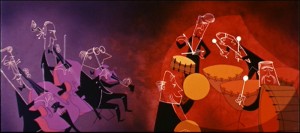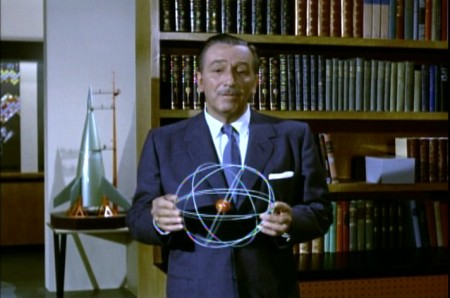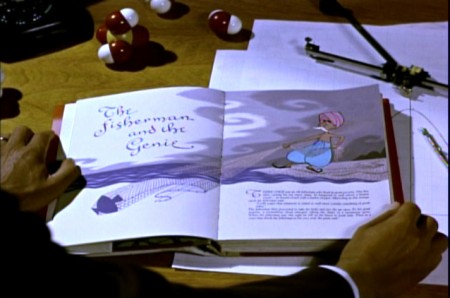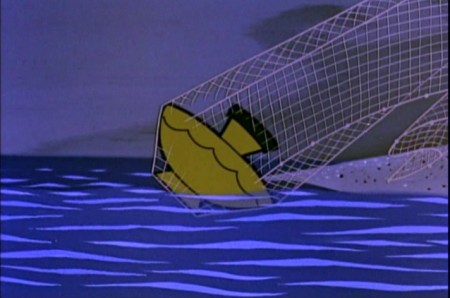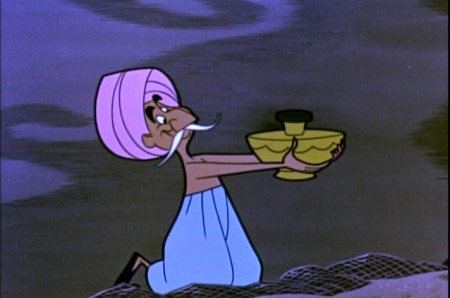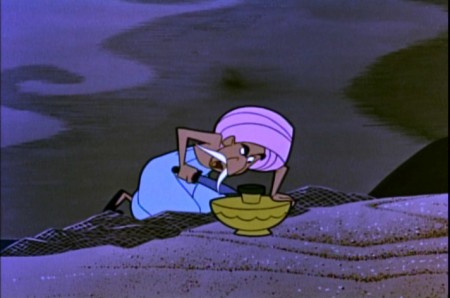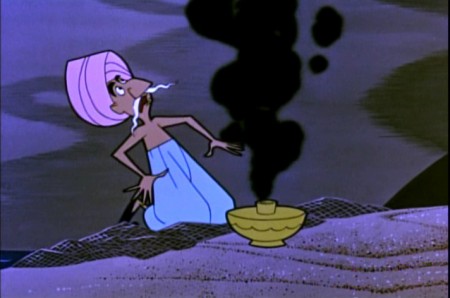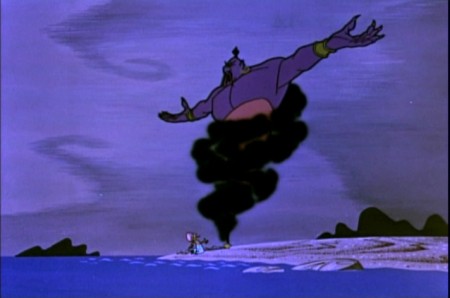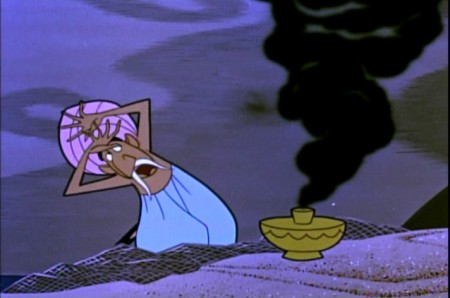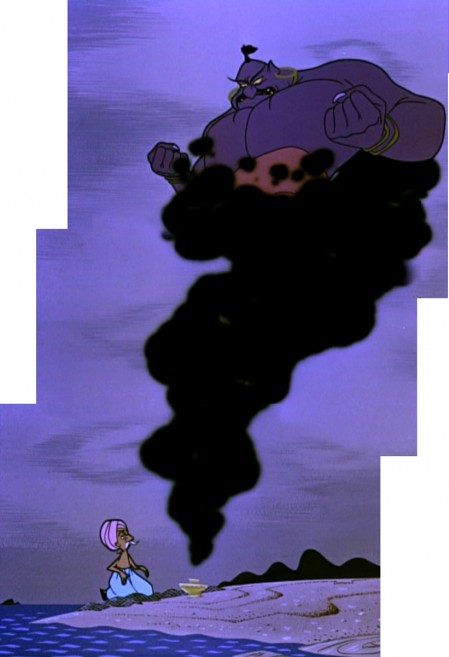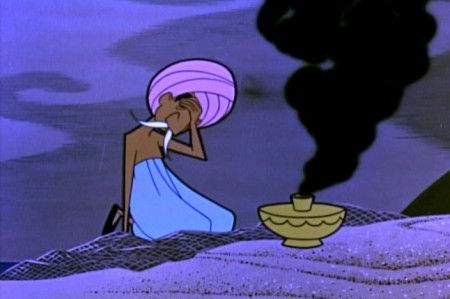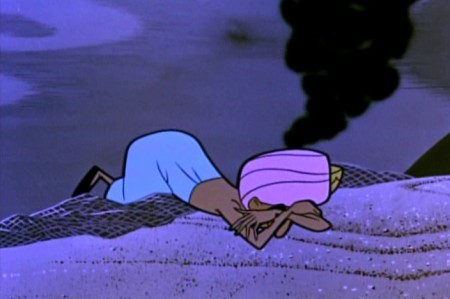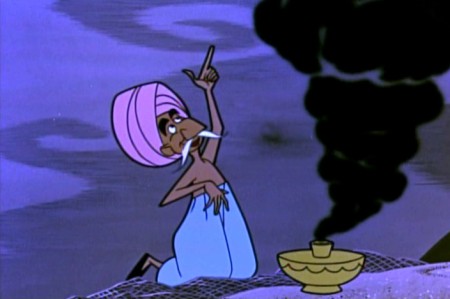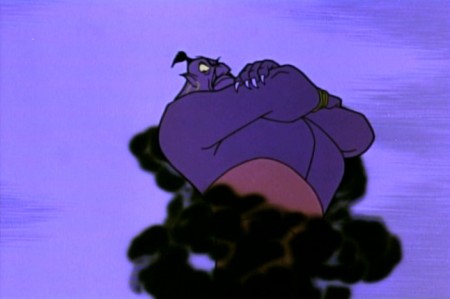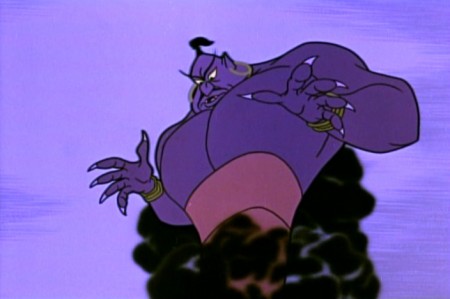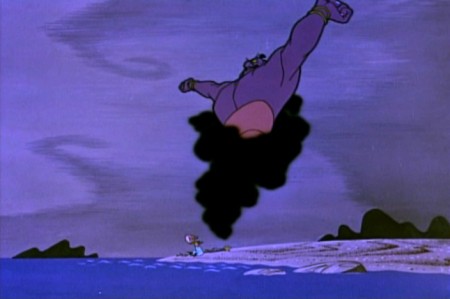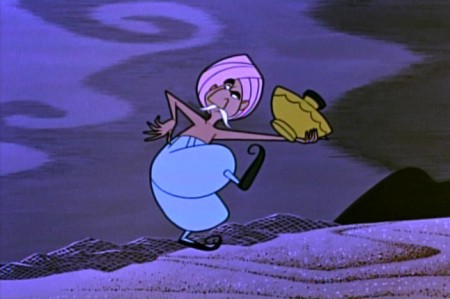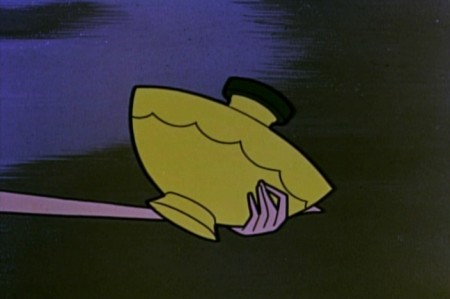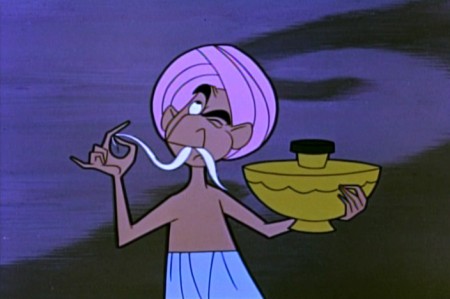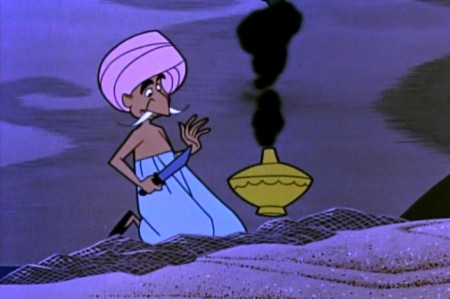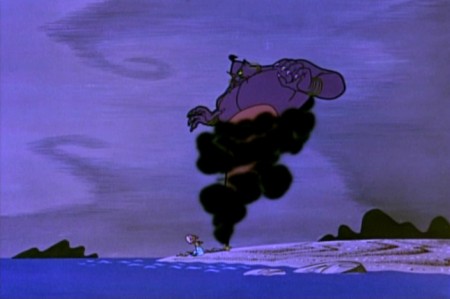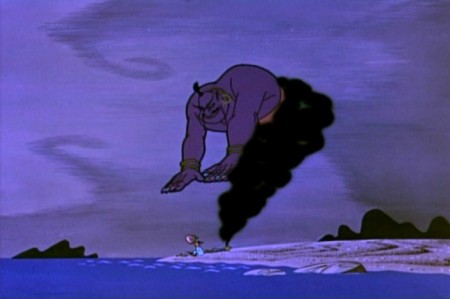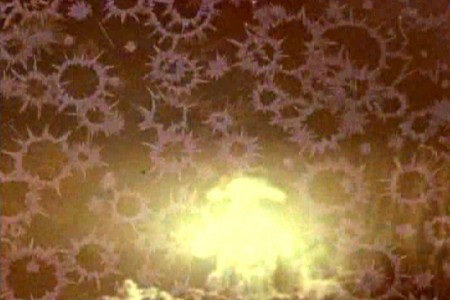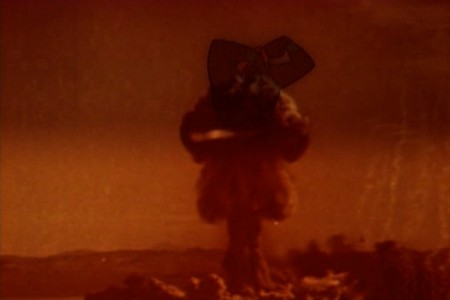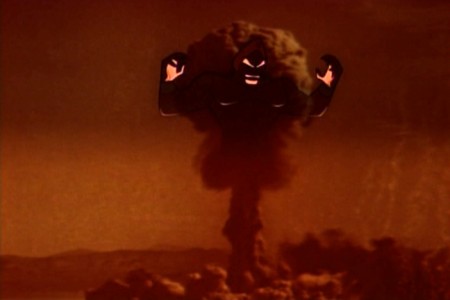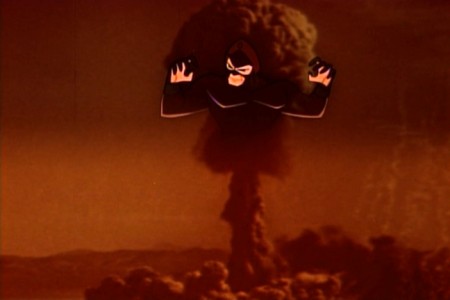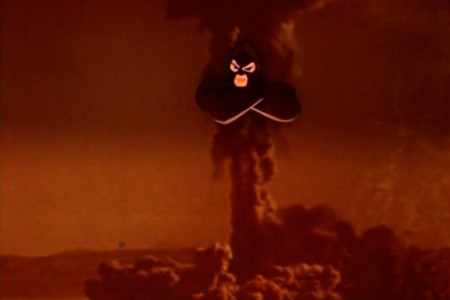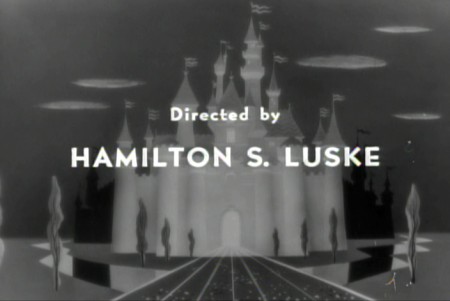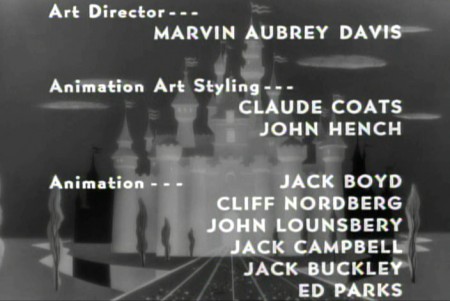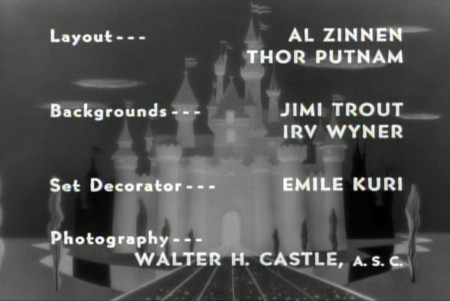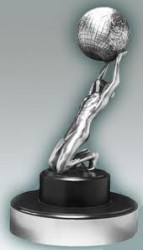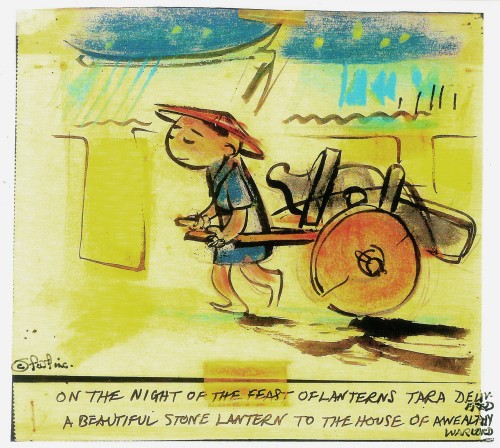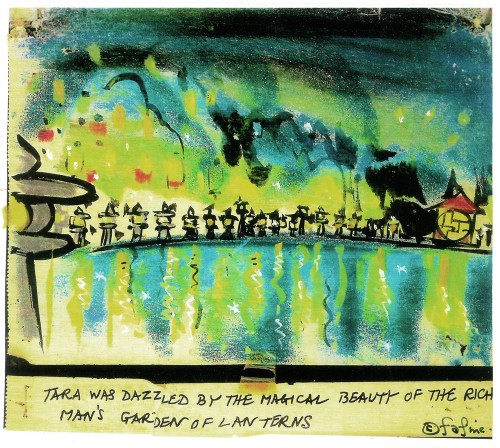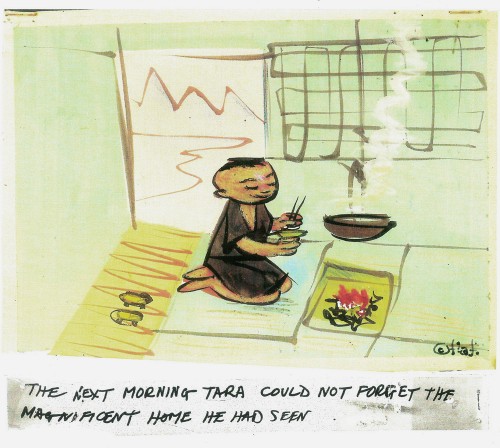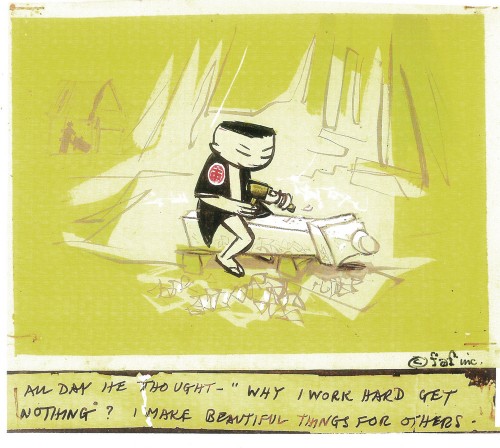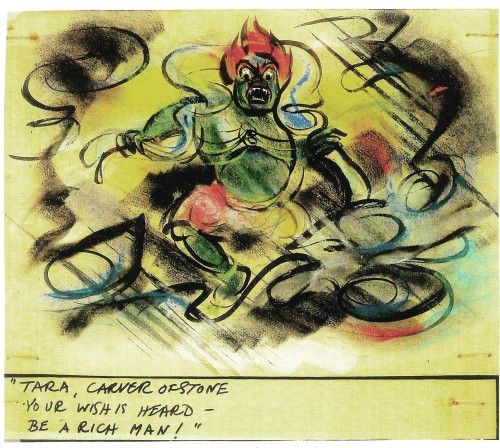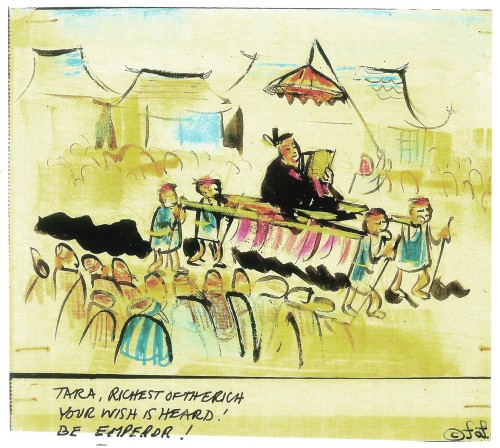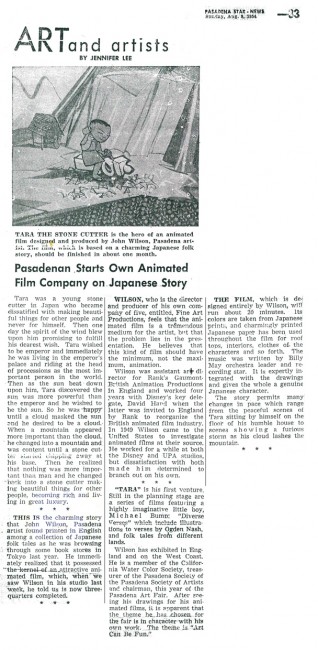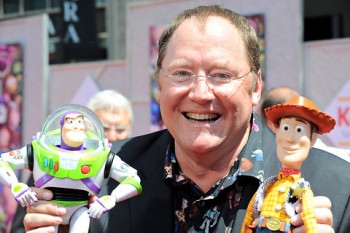Search ResultsFor "kimball"
Books &Daily post 29 Sep 2012 06:55 am
Egos, Books, and Michel Ocelot
There’s been a relatively short conversation going on at the comment section of my blog for an older piece I’d repeated this past week. The discussion has been about Eyvind Earle. The first few visitors who commented all wanted to express their dislike of this film (particularly the story) and Eyvind Earle’s design work, in particular. “Scott’s” dislike of Mr. Earle’s work extends to his personal attitude while working on the film. He, according to “Scott”, was thick headed and wouldn’t listen to any requested changes to his designs, allowing his ego to take charge of the work. (I’m not sure that I see that on the screen, nor did I really feel that when I met the man when I got to spend an afternoon with him as I accompanied Mike Barrier on an interview. I admit it is possible though.)
In fact, I think the ego is essential in breaking new waves and advancing the art form. Adam Abraham in his book When Magoo Flew writes about the ego of John Hubley in running his productions at UPA. If he wanted a specific blue, that’s all that he would settle for. The report is that he was oppressively insistent on it being his way only. I worked for Hubley for years and never got to see that side of the man. Oh, there was a well deserved and big ego there, but it never got in the way of the art being created.
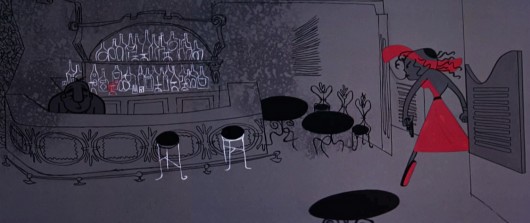
Rooty Toot Toot
We’ve seen Bill Peet complain about Bill Tytla‘s use of his (Peet’s) drawings while working on Dumbo. According to what I’ve read, Peet complains that Tytla took full credit for the sequence of baby Dumbo running in and around his mother’s legs, when Peet felt it was his scene, his key drawings that made the scene the perfect piece that it was.
Chuck Jones, while working briefly for Disney (on Sleeping Beauty), told Walt that he had to leave the studio. When Disney asked what job Jones really wanted at the studio, Jones said, “Yours.” He felt that only Disney’s job was suitable for him. Talk about ego. The ego was even larger than that when you realize that it was Jones, hmself, that told me that story – however real it actuall was. The egos of Jones and Clampett and even Freleng vie over who created what character.
Egos are necessary in an industry of craftspeople and artisans, especially when an artist is trying to get something brilliant out of them. Thomas, Johnston, and even Kahl were brilliant actors with amazing abilities of draftsmanship. But the film, the bigger picture, needed a direction which Earle gave it. Just look at the wretched Reitherman films to see what Thomas, Johnston and Kahl turned out without the strong, smart director who was also an artist. Tytla took animation to another level, he was truly an artist, himself, but look at the miserable little films he directed when he left Disney’s studio. Even the support system of that studio wouldn’t have helped Leprechauns Gold or Snap Happy. (Mind you, I love Snap Happy, but it has no relation to art.)
Here’s a small piece David Parfitt wrote:
- Tytla was a tough guy who used abusive language and irritated his fellow animators. Ken Anderson (Disney Legend for Animation and Imagineering) went to Walt Disney to express frustration at the way Tytla treated his coworkers. Walt Disney replied, “What do you think of Chernabog, the God of evil, in ‘Fantasia’? What do you think of Stromboli in ‘Pinocchio’?†Anderson (the art director for both films) replied, “They are some of the most powerful and vicious villains we’ve ever done.†Walt Disney looked at Anderson and said, “Where do you think all that anger comes from?†Vladimir Tytla was a maverick who needed to release anger and energy to manifest some of the most powerful imagery ever produced by the Disney Studios. A maverick is difficult for a company to grapple with because of their abrasiveness and the way they go against the way things typically run. Yet out of the agitation and irritation often comes a new direction that could secure a company’s future.
Sleeping Beauty changed the Disney studio forever. The animators and artists there, with the exception of Ward Kimball and a few others, fought against the use of 20th century graphics in their films, yet UPA’s influence slowly crept into the mix. Finally when Walt Disney, himself, chose Eyvind Earle and put full support behind him to design this film as he saw fit. The animators all fought Earle and continued to bad mouth him to the end of their days. Yet Earle’s style, as well as Tom Oreb‘s great character designs for that film, are frequently copied by the new generations of artists. The backgrounds and some of the character design are stolen directly from Sleeping Beauty. Even though the SB art is a play on 15th Century manuscripts and art, it was used for the Pocahontas forests.
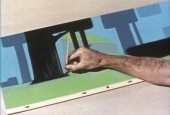
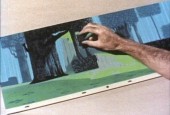
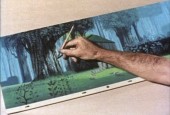
Painting Sleeping Beauty
Nothing at Disney, with the possible exception of Bedknobs and Broomsticks went back to the past to illustrate their films henceforth. Until, of course, today’s new artists in animation who just steal from other past films. Bluth‘s Small One or is virtually without style. Tim Burton is possibly the only exception I can see of this current view of the state of animation. The regurgitated past of other artists who deservedly had egos aglow. We go on. Perhaps someone like Genndy Tartakovsky will bring some of the panasche he brought to Samurai Jack.
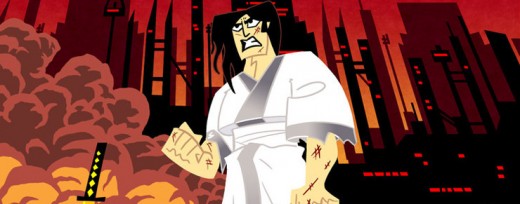
Samurai Jack
By the way, there’s a good interview with Tartakovsky on this week’s on-line version of the Village Voice.
Books
.
- There are a couple of books I’d like to write about.
.
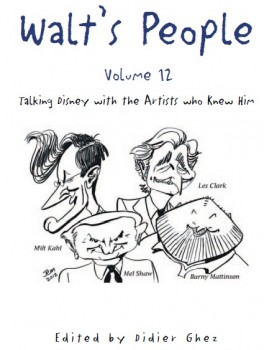
- Let me mention Didier Ghez‘ latest volume of his interview series, Walt’s People.
Just released is Walt’s People – Vol. 12. Just the idea of 12 volumes of any book in print, is quite extraordinary, and amazing feat for Didier Ghez to pull off.
I own about a half dozen of this series and have read all of them at least twice. Most of the interviews are exceptional, some are smart, and the rest are just very good. In all there are those interviews that give us some real insight into the process and history of the making of animated films by the professionals who did it. Les Clark, Larry Clemmons, Charlie Downs, Al Eugster, Sammy Fain, Milt Kahl, Burny Mattinson, Paul Murry, and Mel Shaw are among the many who are interviewed in depth for this new volume. Some of our greatest historians (Robin Allan, Michael Barrier, Albert Becattini, John Canemaker, John Culhane, Pete Docter, Chris Finch, J.B. Kaufman, Jim Korkis, Dave Smith, and Charles Solomon among others) conduct the interviews.
It’s just another great volume in the series. You should own them all; I should own them all, to be honest, and I will.
Ganesha’s Sweet Tooth
- As previously reviewed on this blog, Sanjay Patel will see his first children’s book, Ganesha’s Sweet Tooth released this week by Chronicle Books. I have a sore spot for Mr. Patel’s work. He’s an artist who works by day at Pixar and is an artist, with his own very defined style, working extensively after hours.
I’ve reviewed many of his books and have a real fondness for The Ramayana. Were I you, looking to explore this artist’s work, I’d buy Ganesha’s Sweet Tooth. Once you have it and want more – you will – go for The Ramayana. It’s a brilliant masterwork.
Snow White x 2
- Unless you’ve been hiding under a rock, if you’re an animation fan, you know that the brilliant historian, J.B. Kaufman, has not one but TWO books on Snow White about to appear on the market.
The Fairest One of All: The Making of Walt Disney’s Snow White and the Seven Dwarfs and
Snow White and the Seven Dwarfs: The Art and Creation of Walt Disney’s Classic Animated Film
are the two titles by Kaufman that focus in great depth on that film and its development. This is to celebrate the 75th anniversary of the feature, and will coincide with a display that will appear soon at the Walt Disney Family Museum in San Francisco.
Both books come from the Walt Disney Family Foundation in conjunction with the Walt Disney Family Museum. I’ve seen the Art of Creation book, and was completely taken with it. I will most definitely own both books. The film means much to me, and I want to own anything Kaufman writes. It’s a no-brainer – double my pleasure.
By the way, part of the reason I’m looking forward to reading these two books is to compare it with Michael Barrier‘s amazing writing on this period at Disney’s studio. In Hollywood Cartoons, there’s a large part of the book dedicated to the development andcreation of this particular film. Then in The Animated Man: A Life of Walt Disney Barrier tells the same information but from a different perspective entirely. This biography of Disney is wholly involved with Walt Disney, the man and artist. It’s a unique turn that we only see in the poorly written Diane Disney Miller book, The Story of Walt Disney. As Walt’s young daughter she could see the story no other way than from his perspective. While waiting for the Kaufman books to come out, read either of Barrier’s books for the best, to date, version of the Snow White story. It’s strong writing.
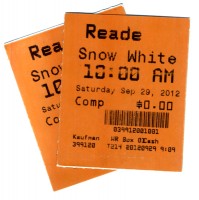 It’s appropriate that I was invited to a 10am screening of Snow White at Lincoln Center this morning. It’s part of the NY Film Festival’s 50th anniversary celebration. Eric Goldberg introduced the film with a brief and smart little talk about the animation. Talking about The Old Mill as a test run for the Multiplane Camera, talking about the Three Little Pigs first offering characters that looked alike but had characterization defined by their animation (as did the dwarfs), talking about The Goddess of Spring being an enormous failure for Ham Luske who succeeded animating Snow White. It was nice to say hello to Eric prior to the film. We haven’t seen each other in about five years. It was nice also to see the film projected. I saw the movie on tv/dvd only a couple of weeks ago, but it’s a very different experience on the big screen. The digital transfer was glorious, merciless and disastrous. The ink lines were so sharp that you could actually feel how deeply the crow quills cut into the cels. However there were many points where individual frames had slight digital distortion to hurt the ink lines, and the magic mirror actually had the detritus of digital compression across the center of the mirror. Someone should have been there to supervise the transfer.
It’s appropriate that I was invited to a 10am screening of Snow White at Lincoln Center this morning. It’s part of the NY Film Festival’s 50th anniversary celebration. Eric Goldberg introduced the film with a brief and smart little talk about the animation. Talking about The Old Mill as a test run for the Multiplane Camera, talking about the Three Little Pigs first offering characters that looked alike but had characterization defined by their animation (as did the dwarfs), talking about The Goddess of Spring being an enormous failure for Ham Luske who succeeded animating Snow White. It was nice to say hello to Eric prior to the film. We haven’t seen each other in about five years. It was nice also to see the film projected. I saw the movie on tv/dvd only a couple of weeks ago, but it’s a very different experience on the big screen. The digital transfer was glorious, merciless and disastrous. The ink lines were so sharp that you could actually feel how deeply the crow quills cut into the cels. However there were many points where individual frames had slight digital distortion to hurt the ink lines, and the magic mirror actually had the detritus of digital compression across the center of the mirror. Someone should have been there to supervise the transfer.
Paperman played prior to Snow White. It was animated cgi, then flattened and lines were added atop the flattened drawings. I can’t for the life of me understand why it wasn’t just animated by hand. It would have cut the cost in half and had more life to it. Sorry, I don’t think it worth the Oscar. Though you never know it may be the best film, this year.
Tales of the Night
- Michel Ocelot has received another excellent review from the NYTimes. Tales of the Nightis reviewed by Andy Webster in the Times, and is Ocelot’s latest feature length animated film – his first in 3D – and the reviews are sensational. It’s screening as part of the Children’s International Film Festival and plays at New York’s IFC Theater through next Tuesday. This is a silhouette film in brilliant color.
His films are beautiful and deserve to be seen in a theater. I’d heartily recommend getting to the theater if you have the chance. Hopefully the distributor will submit this one for Oscar consideration. Though the look is 2D, the graphics are done via cgi as was the case with his past films, including Azur & Asmar, Kirikou et les betes sauvages, Princes and Princesses, and Kirikou and the Sorceress.
Some amazing animation is coming out of France these days.
More Reviews
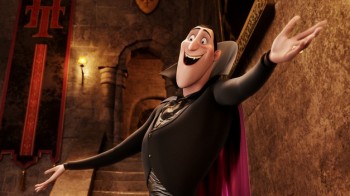 Now to the bigger release for the smaller film department:
Now to the bigger release for the smaller film department:
Adam Sandler‘s second animated feature, Hotel Transylvania, opened to mostly poor reviews by 2nd string reviewers.
NYTimes sent Neil Genzlinger to give his negative review. The most positive line is: “The movie loses its originality as it rolls toward its predictable conclusion, but it’s still lovely to look at.”
Someone named Sara Stewart reviews the film for the NYPost and gives it a middling 2½ stars. “Director Genndy Tartakovsky (“The Powerpuff Girls,†“Samurai Jackâ€) is a natural fit for this kid-and-parent-friendly flick. The animator’s wit and attention to detail enliven a collection of well-known ghosts and ghouls. (Though Tartakovsky’s more traditional TV-cartoon style is still superior, as evidenced by his playful closing credits.)”
Joe Neumaier, the 2nd rate first stringer of the NYDaily news gave it a mostly positive 3 star review. “This being a Sandler movie, the humor skews toward the infantile (fart jokes, peeing baby werewolves). But the sleek visuals are rich and glossy, placing the characters, who look like Halloween door decorations, in baroque hallways or secret passageways.”
I enjoy the reviews in The Onion, and their review for this film by Tasha Robinson doesn’t disappoint. A C+: “Tartakovsky gets a long way on wild design and visually daring sequences. His work has always been adventurous, experimental, and conceptually creative, and he hasn’t lost any of his energy or capacity for staging a memorable setpiece.”
Whatever happened to the feature length version of Samurai Jack that J.J. Abrams was going to produce wth Tartakovsky directing?
Commentary 25 Aug 2012 05:56 am
Commentary Times
Tissa David‘s nephew, Mate Hidvegi, sent me a number of excellent photos of Tissa, which were shot in this past year. I’d like to share a couple of the pictures Mr. Hidvegi has shared with me.
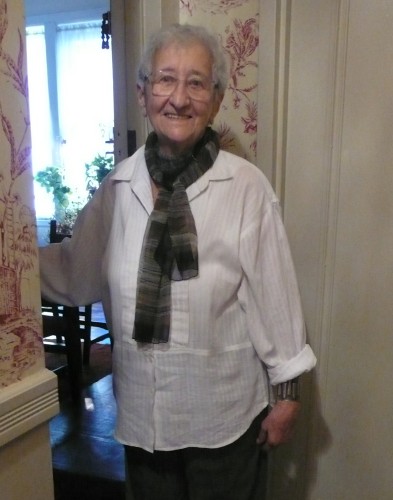
Tissa, greeting visitors as they get off the elevator. May 2012
This is exactly how I remember and will remember her.
A perfect photo.

Tissa’s good friend, artist Judith Reigl, drew this portrait
of Tissa in 1942. (Owned by Tissa’s sister, Katalin David.)
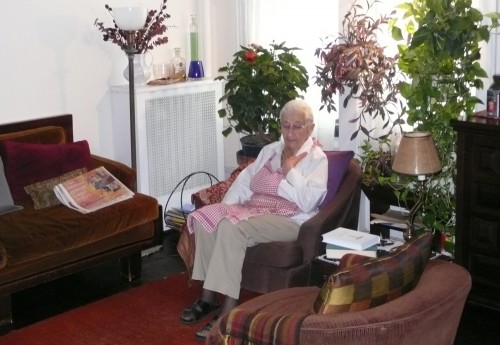
Tissa, sitting in her living room, May 2012
This is an amazingly beautiful photo.
Enlarge it for the full picture which is exact and accurate in its colors.
Years ago, I remember sitting through Fantasia at a private screening in John Canemaker‘s apartment. This was before the days of home video or dvd. John had secured a beautiful 16mm print for the occasion. This film was seminal to John’s life and spirit; I knew that and I suspect that Tissa also knew it. I’d also seen the film about 20 times in the year prior to that screening; it had just been re-released in NY for the first time in many years. I felt that the film had some of the greatest work of the Disney artists, and I also felt that it had some enormous lows.
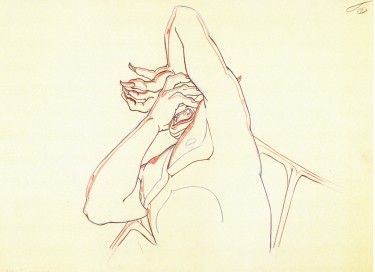 At the end of the film, Tissa immediately piped up and proclaimed it a horrible movie. (John used to impersonate Tissa’s comment for years after, and it always brought a laugh.) She was overstating her thoughts, obviously, but for comedic effect. She hated the Pastoral and other kitschy parts of the film, but she undoubtedly loved the brilliance of Bill Tytla‘s devil or the strength of Reitherman‘s dinosaurs. Even the excellence of Kimball’s Bacchus couldn’t be denied. However, the overall effect was questionable, especially in that apartment screening where it wasn’t the overblown big screen and stereophonic sound version, and its flaws were more obvious.
At the end of the film, Tissa immediately piped up and proclaimed it a horrible movie. (John used to impersonate Tissa’s comment for years after, and it always brought a laugh.) She was overstating her thoughts, obviously, but for comedic effect. She hated the Pastoral and other kitschy parts of the film, but she undoubtedly loved the brilliance of Bill Tytla‘s devil or the strength of Reitherman‘s dinosaurs. Even the excellence of Kimball’s Bacchus couldn’t be denied. However, the overall effect was questionable, especially in that apartment screening where it wasn’t the overblown big screen and stereophonic sound version, and its flaws were more obvious.
Tissa blew the same trumpet on many other Disney features. There was a Museum of Modern Art screening of Jungle Book with Eric Larson, Ken Anderson and Gilda Ratner present to talk. I had all I could do to stay awake during the film. (Those horrible voices – Phil Harris, please!) Finally, it ended, and Tissa whispered the opinion, “What a dreadful movie!” I could only laugh. I thought I was the only one with that opinion, and she was voicing my thoughts (and covering up the fact that I slept through it.) We laughed together.
She absolutely loved Frank Thomas’ squirrel sequence from Sword in the Stone.As a matter pf fact, she had a soft spot for a number of Thomas’ sequences.She also loved Marc Davis’ work. His Cruella de Ville certainly stood out. Tissa surprised me during Beauty and the Beast when she praised a half shot of Belle walking and said it was a good walk. (This was within the castle while a prisoner of the beast.) You couldn’t see Belle’s feet, but Tissa believed it. This was high praise from her. By then I’d been concentrating more on the direction than the animation, so I was glad she caught me not paying attention to the screen action. She woke me up again, in a different way this time.
There were many gems Tissa praised to the hilt. The first time we saw Caroline Leaf‘s film, The Street she was full of superlatives. Tissa was a judge in Ottawa when Norshtein‘s Tale of Tales won Best in Show, and it deserved it. We sat through that film many times together. We both loved it. The Quay Brothers confused much of the audience that year with their early film, Nocturna Artificialia, but she loved it. Sodid I, and we spent a lunch talking about it.
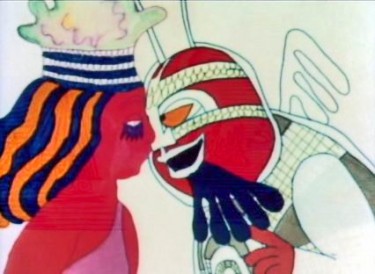 In 1974, she opted not to work on the Hubley film, Voyage to Next (she never told me the reason though I believe it was because John was lowering her salary considerably – he had so little money on this film – and she had to stand up for herself), but she praised, privately to me, the animation of Bill Littlejohn even though she wasn’t crazy about the final film.
In 1974, she opted not to work on the Hubley film, Voyage to Next (she never told me the reason though I believe it was because John was lowering her salary considerably – he had so little money on this film – and she had to stand up for herself), but she praised, privately to me, the animation of Bill Littlejohn even though she wasn’t crazy about the final film.
She shared a long list of things she didn’t like in her own work on films like Eggs, and Raggedy Ann. She also loved working on both films, and loved working for both directors – John Hubley and Dick Williams. After working on animation for Candide for Bob Blechman – low salary long hours and difficult but beautiful work – she told me privately that she would not work on any more films for Bob. She hated how the studio had reworked her animation and changed the cutting. She felt all her hard work had been damaged.
In short, I learned from Tissa that I should trust my judgement. I also used judicious thought in airing my opinion; I was always concerned about hurting the feelings of others. Tissa showed me that I had a strong and contrary opinion, but really I was just looking for my idea of quality. It was easy to say how much I liked things I didn’t, but it was hard to speak the truth and tried to articulate why. It isn’t always easy, but it’s certainly necessary for me. I suppose that makes me not always liked within the community, but the art of animation is too important for me. If my honest opinion gets someone to do better, it’s worth it.
Not too long ago an award winner at an animation festival offended me. At the after party, I told the film maker that his half of a walk cycle was an unforgivable cheat. The budget was the excuse that didn’t sit with me, and I stupidly hurt the animator/director. He hasn’t done half a walk cycle again, and I think my rudeness paid off. Especially in that he’s a gifted artist, and his work was better than what he offered us – even winning an award.
Tissa’s unforgiving critiques of my work, and there were many of them – many – over the years was always helpful. Every single comment from her, whether about my work or other people’s work, taught me something. The positives meant so much more because the negatives were just as honest. I’ll miss her barbs and her lessons. However, I have to say my own opinion of my work is more critical than she ever could have been. I just don’t have a second voice to back me up anymore, and I seriously miss that.
UPA Production Numbers
- Following in the lead of Thad Komorowski‘s listing of production numbers from M-G-M and Warner Bros cartoons, Adam Abraham has opted to add all Production Numbers, he has for the UPA films. This list is complete to about 1956 and includes all the Columbia shorts.
This site, When Magoo Flew, is not only a good companion to the book but is excellent and informative in its own rite. There’s plenty of information here that doesn’t even appear in the book.
Paul Rand . . . I mean Ayn Ryan
- For all those psychotic Paul Ryan lovers, Ayn Rand‘s The Fountainhead will be broadcast on TCM on Sunday, August 26 at 02:30 AM.
This gave me one of my favorite moments as an Academy member. It was a memorial service for Gary Cooper, who had died way back in 1961. They had clips from a number of his great films and a number of speakers who were part of his life (or he was part of their lives.) It was moving smoothly when Patricia Neal came to the microphone, dressed in a bright, slinky, crimson dress. She gave a short-ish speec which started with,”
“Gary Cooper was the love of my life.”
She revealed something that was obvious to many at the time. She and Cooper, while filming The Fountainhead, fell in love. Cooper was married and loved his wife. He would not leave his wife and child for Patricia Neal on her first film. The affair turned to an end. Neal was brokenhearted and told us, many years after. She told us she still loved Gary Cooper. It was a very emotional speech.
They followed with a clip from The Fountainhead.
Maria Cooper, Gary Cooper’s daughter, followed the clip and didn’t talk about Patricia Neal.
Olympiad Twenty
I’ve received a notice about the following animated short pieces geared to the Olympics. (Better late than never.) They’re very short animated clips that lead one into another. The note that came with the email read as follows:
- We’ve just made a series of 7 x 20 second animations in just two weeks with
one animator, which is getting really good feedback.
Wondered if you might like to see our animation and share it if you like?
Any feedback you can offer is most appreciated.
Kath Shackleton, Producer
Fettle Animation
Personally, I’m not the biggest fan of the material, however, I thought many of you would like them. The punchlines are consistently nasty and unpleasant, making the stories not very interesting to me. The animation seems excellent for Flash type work. A lot of labor went into them; I wish the writing had been more creative rather than nasty.
Please feel free to leave your comments for them; I’m sure many of you will like them more than I. It’s just my sentiment – my taste – in this period of world history.
Animation Artifacts &Disney &John Canemaker &Story & Storyboards 02 Jul 2012 04:43 am
Toot Bd – repost
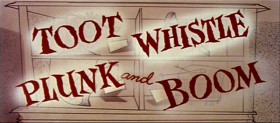 - Our Adventures in Music continue with the preliminary storyboard for what would ultimately become Toot Whistle Plunk & Boom. This is another board on loan from the archives of John Canemaker, and you can see the outgrowth from the prior film, Melody: Adventures in Music.
- Our Adventures in Music continue with the preliminary storyboard for what would ultimately become Toot Whistle Plunk & Boom. This is another board on loan from the archives of John Canemaker, and you can see the outgrowth from the prior film, Melody: Adventures in Music.
You can see how little of the magic was in this board, yet it obviously inspired others to keep it alive and make it work. Ward Kimball has to get most of the credit, though designs by Tom Oreb, Ken O’Connor, Eyvind Earle and Victor Haboush sure brought it to life.
The material I’m posting here is on large photostat copies. The problem is that the images are a bit fuzzy, and the text beneath the boards is illegible. In some cases, the appropriate text has been hand written on the copies themselves.
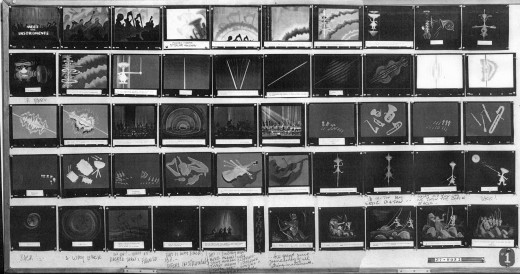 1
1
These are breakdowns of each row of the boards so that the images can be made as large as possible. Each row of images is split in two and labelled accordingly. #31a means Board 3 row 1 part a.
 11a
11a
 31a
31a
Ward Jenkins has posted some beautiful frame grabs from the completed film. Go here.
See this short on YouTube here.
John Canemaker deserves all the kudos he gets for lending this material to me as well as plenty more that he’s loaned this blog.
Animation &Disney &Frame Grabs 27 Feb 2012 08:22 am
Our Friend the Atom
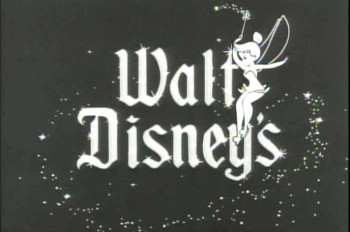 - When Disney released 20,000 Leagues Under the Sea, there was a curious and opportune time for some cross promotion with Disney doing a “Tomorrowland” show for his Disneyland program. Our Friend the Atom talks about atomic energy driving the Nautilus submarine in the Jules Verne film that Disney was pushing. (Of course, Verne wrote of an “electric ship,” but Disney in the mid-fifties had to be thinking nuclear.)
- When Disney released 20,000 Leagues Under the Sea, there was a curious and opportune time for some cross promotion with Disney doing a “Tomorrowland” show for his Disneyland program. Our Friend the Atom talks about atomic energy driving the Nautilus submarine in the Jules Verne film that Disney was pushing. (Of course, Verne wrote of an “electric ship,” but Disney in the mid-fifties had to be thinking nuclear.)
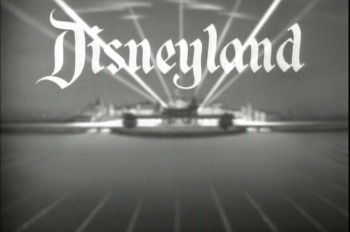 Ham Luske directed the
Ham Luske directed the
show, and I have to say some of the animation is spectacular. I really love the look of this stuff. I feel like the representation of the Genie is magnificent. There’s a feeling that they capture which really invokes the Arabian Nights figure that I read. (I was a bit turned off by the WB feel of the Robin Williams Genie in Aladdin, though I am in awe with what Eric Goldberg did with it. I guess I’m too much of a purist with some of these folk/fairy tales.)
I had always given Ward Kimball credit for the show until looking at it again. Whereas all the shows Kimball did had a light approach toward the science, trying to make it as much fun as possible, Our Friend the Atom is dead serious with very little humor underneath it. Somehow, I loved this show more and was very impressed with the strength of that Genie.
I’ve taken some frame grabs of the first segment to give an idea of it. The show is available in one of those Walt Disney Treasures – Tomorrow Land: Disney in Space and Beyond
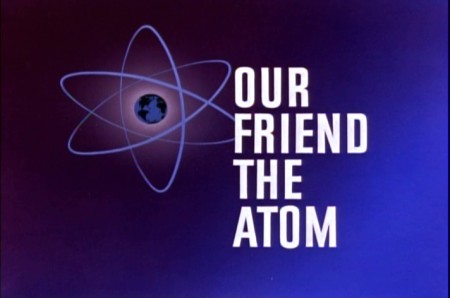 1
1
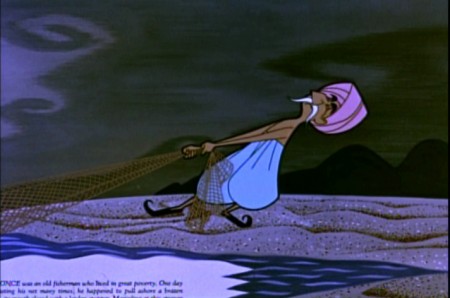 4
4
Note how they keep the type in the book illustration as they did
in the Winnie the Pooh adaptations which were done years later.
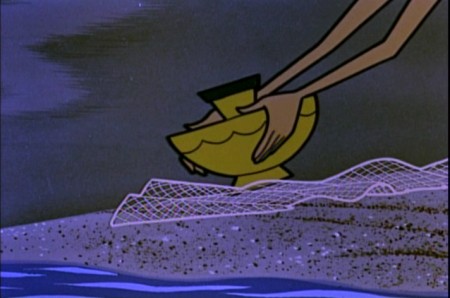 6
6
Just pure fine visual storytelling in this section.
It really is very well done in its conservative editing.
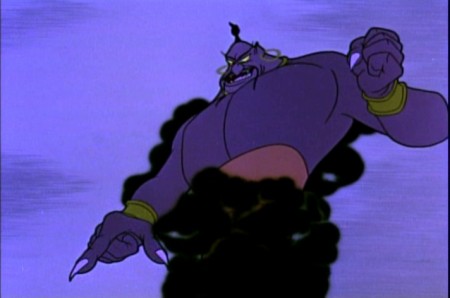 11
11
The Genie is going to take advantage of the fisherman
who has released the demon into the world.
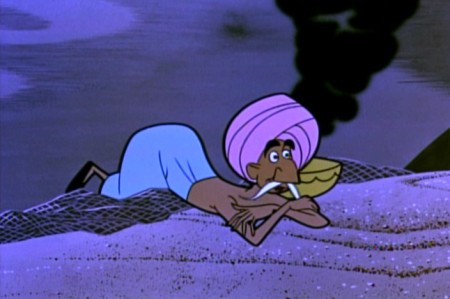 16
16
But the fisherman gets an idea.
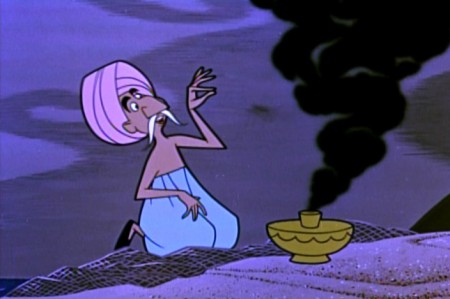 19
19
He says he doesn’t believe that the Genie
could not have fit into so tiny a lamp.
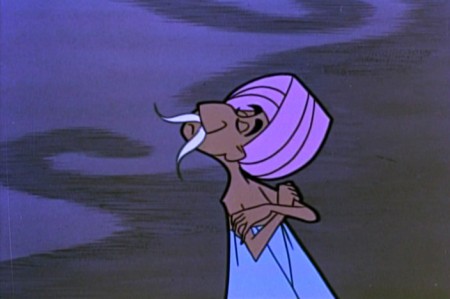 21
21
He challenges the Genie to prove that he can fit into the lamp.
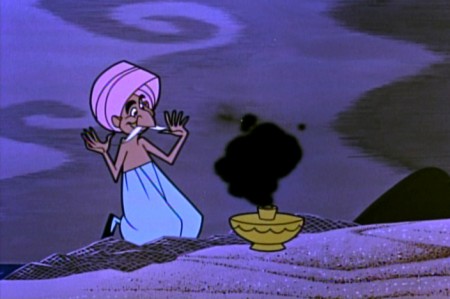 23
23
The Genie goes back in . . .
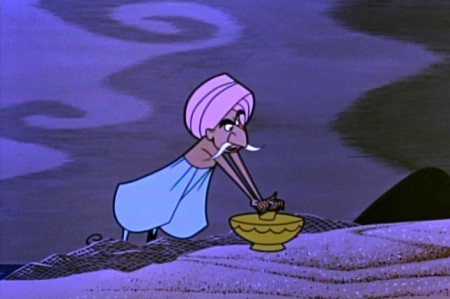 24
24
. . . the fisherman stops him in there.
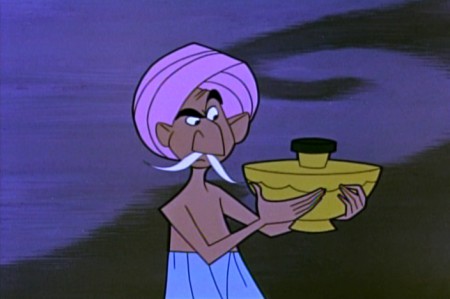 27
27
The Genie makes a magnificent deal
if the fisherman will let him out again.
.
The program then goes into the history of the discovery of radiation and the atom and control of atomic energy.
.
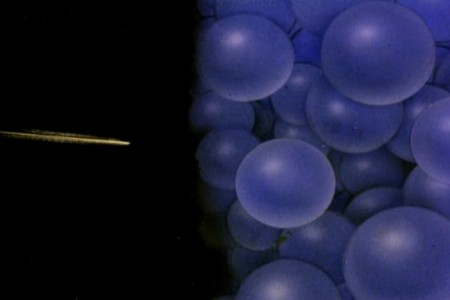 32
32We pick things up with the splitting of the atom.
 34
34
A chain reaction gets things going.
Animation &Commentary &Independent Animation &Richard Williams 18 Feb 2012 08:56 am
Sheldon Cohen & John Gaug and Arrietty and NAACP Image Award
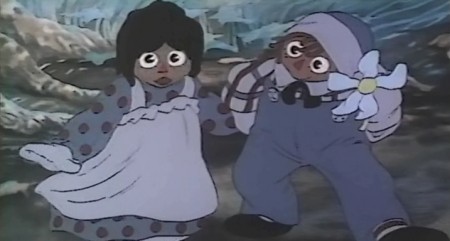
Tissa David‘s enormous seminal Raggedy Ann scene.
The rest of the film was built on the back of this one.
- Back in 1976, I was lucky enough to get hired onto Raggedy Ann and Andy, a feature film Bobbs Merrill was financing with Richard Williams as the newly employed director. I was the first non-animator hired (three animators were hired before me: Tissa David, Art Babbitt, and Emery Hawkins. Corny Cole was designing and doing the storyboard; Gerry Potterton was the assistant director.
When the studio was set up, with its headquarter in New York, they chose a space in a building that had entrances on 45th and 44th Streets just off 5th Ave. The space was enormous and dark. Many of the lights were usually left off. Sometimes the office manager, Bruce , would be there. but for the most part, while the voices were being recorded, I was alone in the space.
I decided to start buying animation desks and discs and other equipment. I did this and worked with someone to get holes cut and lighting set up in the desks. We started prepping partitions and just setting up everything. Once bits of animation started coming in Assistant Animators were hired. Jim Logan was the first, and he and I worked together for several months with little to do but laugh and do bits of inbetweening for animation tests.
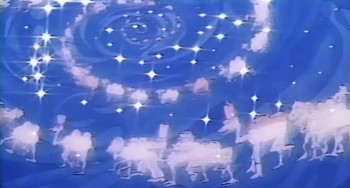 Dick Williams gave me a scene of a mirage the Camel with the Wrinkled Knees would have. 97 dancing camels spiraling into the distance would be superimposed over the Camel’s head. I worked for about six weeks on this one scene, and until I had to be taken off it. The scene near completion went to the newly hired John Kimball who was going to do a number of other similar scenes, and he’d build them all into the film. I moved to head of Assistants and Inbetweeners and definitely had a lot of work to do.
Dick Williams gave me a scene of a mirage the Camel with the Wrinkled Knees would have. 97 dancing camels spiraling into the distance would be superimposed over the Camel’s head. I worked for about six weeks on this one scene, and until I had to be taken off it. The scene near completion went to the newly hired John Kimball who was going to do a number of other similar scenes, and he’d build them all into the film. I moved to head of Assistants and Inbetweeners and definitely had a lot of work to do.
Hiring lots of people in New York and training many of the new faces was foremost. We ended up with seven rooms with about 15 Assistants and Inbetweeners in each room. Finding new people wasn’t always easy, and they didn’t all work out.
In 1976, the Ottawa Animation Festival had its inauguration year. (That was when Caroline Leaf took over the animation world, becoming a star with her film, The Street.) It was here that I went to look for talent, and I found it in several people. John Gaug came down from Atkinson Film Arts in Ottawa. He was a gifted talent and a very tight style. Sheldon Cohen was closer to my heart. His sensitive drawings and warm approach to the artwork made him a definite person to hire. After getting back to New York I let the powers-to-be know that I was hiring the two and made the calls. Both moved dpwn to the City.
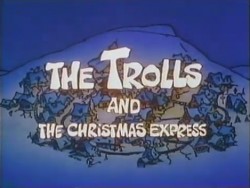 Both continued on after Raggedy Ann ended.
Both continued on after Raggedy Ann ended.
John Gaug moved on to the Williams studio in London where he became an animator, moved back to Ottawa to direct Trolls and the Christmas Express (where I animated freelance for him). Then he moved back to New York working in the commercial studios (I got to hire him again at R. O. Blechman’s studio) until he died in 1984.
.
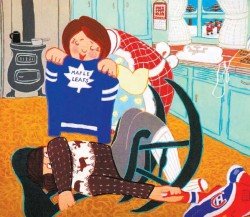 Sheldon Cohen moved back to Montreal where he became a unique artist for the National Film Board. He directed and animated a number of strong films. His most famous, The Sweater, showed an artist in full bloom seemingly right out of the box. He continues doing a number of children’s books and recently has written a oersonal memoir called This Sweater Is For You! published by ECW Press in Toronto. The book will soon be on the market, I’ll get a copy and will definitely review it. I’d also like to interview Sheldon about his 40 year career of making art.
Sheldon Cohen moved back to Montreal where he became a unique artist for the National Film Board. He directed and animated a number of strong films. His most famous, The Sweater, showed an artist in full bloom seemingly right out of the box. He continues doing a number of children’s books and recently has written a oersonal memoir called This Sweater Is For You! published by ECW Press in Toronto. The book will soon be on the market, I’ll get a copy and will definitely review it. I’d also like to interview Sheldon about his 40 year career of making art.
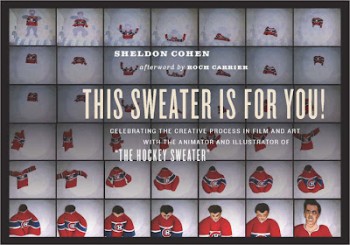
In the meantime, you can see a number of Sheldon’s films on the NFB site. I’ve linked those films below.
The Sweater is an adaptation of a Mordecai Richler short story.
I Want a Dog is based on the book by Dayal Kaur Khalsa.
Snow Cat starts out with the feel of the book Goodnight Moon
but soon turns to a very graphic and textured look.
It’s a 23 minute film with wonderful narration by Maureen Stapleton.
Pies, a film about blind prejudice, is based
on a short story by Canadian author Wilma Riley.
_______________________________________________________
Ghibli’s The Secret World of Arrietty opened yesterday to generally positive reviews.
- Manohla Dargis in the NYTimes praised the Ghibli approach to female characters, who often are the leads, but was bothered by some of the elements lost in adapting the original novel, however
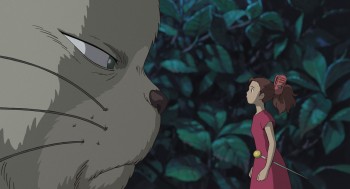 “. . . it’s initially a letdown that Arrietty and Shawn aren’t just friends, as in the book, but also something like impossible romantic foils. Yet this disappointment proves mostly premature because Studio Ghibli and Arrietty have a way of taking you where you may not expect, whether you’re scrambling through rooms as large as canyons or clambering into the safety of an outstretched hand, a simple gesture that says it all.”
“. . . it’s initially a letdown that Arrietty and Shawn aren’t just friends, as in the book, but also something like impossible romantic foils. Yet this disappointment proves mostly premature because Studio Ghibli and Arrietty have a way of taking you where you may not expect, whether you’re scrambling through rooms as large as canyons or clambering into the safety of an outstretched hand, a simple gesture that says it all.” - Lou Leminick in his 3 star review in the NYPost writes:
- Studio Ghibli is at the forefront of keeping traditional hand-drawn animation alive — and it works well even for a story that’s less fantastical than Miyazaki’s signature works.
- Many animated and live-action films have dealt with miniature humans, but few have depicted a sheer sense of scale as effectively as this one.
“The Secret World of Arrietty’’ is a feast for the eyes that will engage the entire family.
- Phillip French in The Observer writes a very positive review:
- At the heart of the film, is the tender, trusting friendship between Shawn, the boy of the house, and Arrietty. Theirs is a beautiful, perfect love, but ultimately doomed like so many relationships in myths and fairytales. This moving, amusing and resonant tale also touches on environmental and ecological concerns, on xenophobia and the fear of the threatening other. And it has taken on new meanings about the respect and preservation of disappearing species and the need to treasure and recycle valuable resources.
.
- Finally, the good news, last night, I won the NAACP IMAGE Award for Outstanding Children’s Program. I’m proud of this one, thankyou very much.
Outstanding Children’s Program
“A.N.T. Farm”
“Dora the Explorer”
“Go, Diego! Go! ”
WINNER: “I Can Be President: A Kid’s-Eye View”
“My Family Tree”
.
Animation Artifacts &commercial animation &Independent Animation 09 Jan 2012 06:18 am
John Wilson/Fine Art Films – part 1
- For the next three weeks, I’m going to focus on director/designer/animator, John Wilson.
Amid Amidi presented me with some art that he thought might be a good match for this blog, and it is. So I’ll take advantage of the material and share it with you. With each week’s post I’ll hone in on one specific film and go from there. We’ll start with Wilson’s first solo film, Tara the Stone Cutter completed in 1955.
But first, let me share some bio information about John Wilson and his company Fine Arts Films.
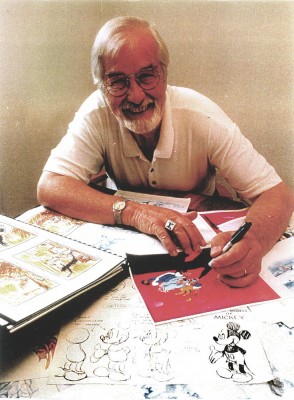 - John Wilson was born in Wimbledon in 1920. He attended the Royal College of Art and was working by age 18 as a commercial artist with Willings Press Service. In WWII he served with the London Rifle Brigade in African where he was seriously wounded. Recuperating in hospital, he drew many cartoons of which several were printed. Eventually he would recover and get work at Pinewood Studios in the art department where he worked on GREAT EXPECTATIONS and THE THIEF OF BAGHDAD, among other films.
- John Wilson was born in Wimbledon in 1920. He attended the Royal College of Art and was working by age 18 as a commercial artist with Willings Press Service. In WWII he served with the London Rifle Brigade in African where he was seriously wounded. Recuperating in hospital, he drew many cartoons of which several were printed. Eventually he would recover and get work at Pinewood Studios in the art department where he worked on GREAT EXPECTATIONS and THE THIEF OF BAGHDAD, among other films.- By the time he was 25, he was working in animation at Gaumont-British Animation, a newly formed division of J. Arthur Rank’s studio, working under the direction of David Hand on the “Animaland” series starring “Ginger Nut.”
- In 1950 he moved to the United States working in layout and animation at UPA. He found himself working with Bobe Cannon, Pete Burness, Jules Engel, and Paul Julian. Eventually he left for the Disney studio working in Les Clark’s ‘Tinkerbell’ unit on PETER PAN and with Ward Kimball on TOOT WHISTLE PLUNK & BOOM.
- He tried to sell Disney on the film Tara, the Stonecutter, but they weren’t interested. He completed it himself in 1955 using a Japanese style to tell the story. Wilson was impressed with the UPA style of modern art in animation, and that’s the route he took for his personal film. Thus his studio was born, called Fine Arts Films, in 1955. Tara had some success playing theatrically with the successful Japanese feature film, GATE OF HELL by Kinugasa (which had won the Oscar for Best Foreign Film.)
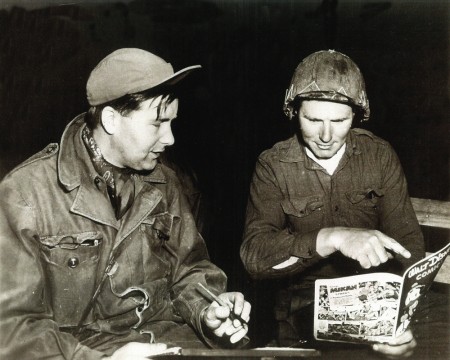
Wilson in Korea with the Bob Hope Tour to entertain the troops.
- This film led to his producing a verion of Stravinsky’s Petroushka for NBC which aired in 1956 as part of The Sol Hurok Music Hour. Notably, Stravinsky, himself, arranged and conducted the shortened version of the score suing the LA Philharmonic Orchestra. The film was designed by John Wilson and Dean Spille with anmation by Bill Littlejohn, Art Davis, and Phil Monroe. Chris Jenkyns, Dean Spille and Ed DeMattia designed the 16 minute show from Wilson’s storyboard.
- Fine Arts Films had produced ‘Journey to the Stars’, a project for the 1961 World’s Fair, an animated voyage through space for NASA, which was seen in 70 mm Cinerama by ten million visitors to Seattle.
- Billy Wilder employed Wilson to do the titles for Irma La Douce after which they did a six-minute trailer for this Jack Lemmon, Shirley McLaine feature. It was all about Parisian prostitutes romping about in Montmartre, and animation could apparently make it acceptable. Artists Ron Maidenberg, Sam Weiss, Sam Cornell and Bob Curtis caught the vivid nightlife of Paris in a sexually charged animated short. It was a huge success in promoting the feature.
- In 1970 Wilson flew to Chicago to see Carol Channing and Eddie Bracken appearing in “archy and mehitabel in Shinbone Alleyâ€. On the basis of this theatrical musical, Wilson bought the screen rights to the book “archy and mehitabel” by George Herriman and began work on an animated feature which was released by Allied Artists in 1971.
- Fine Arts Films was also responsible for many animated commercials as well as weekly music video segments for the weekly CBS-TV series “The Sonny and Cher Show.†The songs included Joni Mitchell’s “Big Yellow Taxi†and Jim Croce’s “Leroy Brown.â€
Here are some storyboard sketches by John Wilson for his initial short film, Tara, the Stonecutter. This film started it all for Wilson.
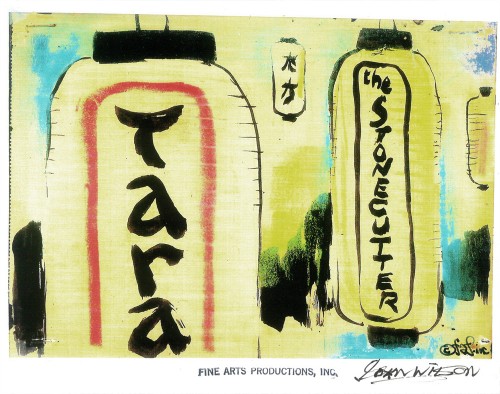 1
1
I haven’t seen the finished film, but I understand that Japanese decorative papers were used in the backgrounds and costumes of the characters.
Here are two press clippings for this film from California papers.
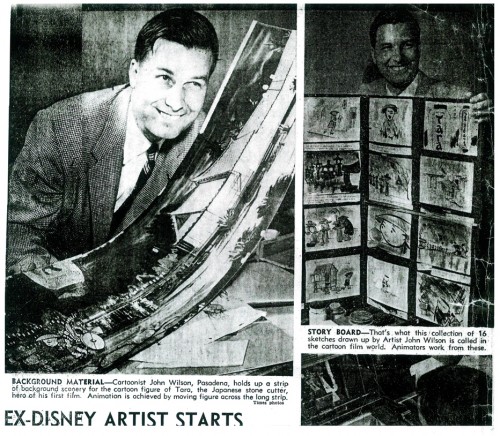
(Click any image to enlarge.)
Commentary 15 Oct 2011 06:44 am
Ramble, Ramble, Ramble
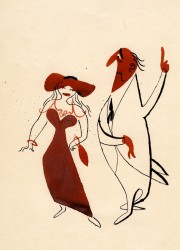 - This past week was a busy week for animation in New York.
- This past week was a busy week for animation in New York.
It started on Monday with the AMPAS celebration of John Hubley‘s early work. It turned into quite an event with beautiful prints of many of the early UPA films which began with the military film, Flat Hatting and led to the brilliant masterwork, Rooty Toot Toot. Some commercials and a few of the early, brilliant films of the Faith & John collaboration, Adventures of an * and Tender Game. It was a sterling evening well attended by many of the key personae in New York’s animation scene.
On the following night, ASIFA East held a retrospective of the work of the late and great Independent animator, Karen Aqua. I was unable to attend this screening but was certainly down about it. Fortunately, there were two key reports describing the show: Linda Beck, the new President 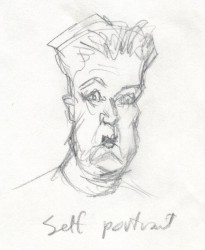 of ASIFA East, described the event on the organization’s blog, and Richard O’Connor of Ace and Son gave a good accounting on his blog.
of ASIFA East, described the event on the organization’s blog, and Richard O’Connor of Ace and Son gave a good accounting on his blog.
- Last night, Bill Plympton hosted a show at the Friar’s Club which featured the NY premiere of the new documentary by Alexia Anastasio, “Adventures in Plymptoons”, about him and his work.
Tonight at 7pm, at the Film Society of Lincoln Center Bill will doing a book signing of his “. . . big Rizzoli book, “Independently Animated: Bill Plympton”‘ He’ll be showing artwork from it and signing books and he’ll also be showing some of his new short films, plus a clip from Alexia Anastasio’s doc “Adventures in Plymptoons!”. All for free.
.BROOKLYN FILM FESTIVAL‘S kidsfilmfest will be screening films from their archives
WHEN: this Saturday, October 15th, from 10am-4pm.
WHERE: The Big Screen Plaza: 29th St between 6th and 7th Avenues in New York
WHO?: Kids of all ages!
WHAT: A selection of kid-friendly films, with in-plaza activities like face painting, balloon artists, popcorn, & more!
Join them for live action and animated films, food, face painters and more! Films are rated “G” for all ages.
The event is free of charge and open to the public.
_________________
 It should also be noted that the films of J.J. Sedelmaier will premiere at Big Screen Plaza on Tuesday, Oct 18th, 7pm. It’s free, outdoors and the atmosphere will be party time.
It should also be noted that the films of J.J. Sedelmaier will premiere at Big Screen Plaza on Tuesday, Oct 18th, 7pm. It’s free, outdoors and the atmosphere will be party time.
Some of the works to be screened include:
__ Saturday Night Live’s “Conspiracy Theory Rockâ€
__ Saturday Night Live’s “Titeyâ€
__ The Daily Show’s “Midterm Electionsâ€
__ Ambiguously Gay Duo: “Safety Tipsâ€
__ Ambiguously Gay Duo: “Ace and Gary’s Fan Clubâ€
__ Ambiguously Gay Duo: “Blow Hot, Blow”
and many others
.
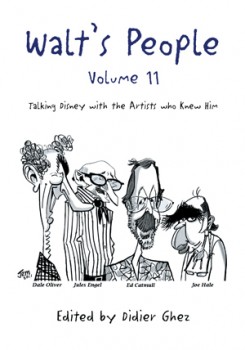
- Didier Ghez has been editing a library’s worth of books featuring interviews with animation professionals. For the most part these are the raw materials historians have worked with in writing their histories. Just now in release is volume 11 of his series, Walt’s People. There are interviews included in this edition with:
John Culhane: I. Klein_________________C. Finch & L. Rosenkrantz: Eric Larson
John Culhane: John Hubley____________Robin Allan: Jules Engel
Darrell Van Citters: Ed Love____________Darrell Van Citters: Mike Lah
JB Kaufman: Frank Thomas____________John Culhane: John Hench
John Canemaker: Ward Kimball________Dave Smith: Ward Kimball
David Tietyen: George Bruns___________John Canemaker: Dale Oliver
John Canemaker: Iwao Takamoto______John Canemaker: Richard Williams
John Culhane: Daniel MacManus________John Canemaker: Glen Keane
Didier Ghez: Joe Hale__________________Jérémie Noyer: Mark Henn
Didier Ghez: Ed Catmull
_________and many others.
The introduction to this edition is by John Canemaker.
You’ll find the book Walt’s People – Vol. 11 at Amazon or Xlibris
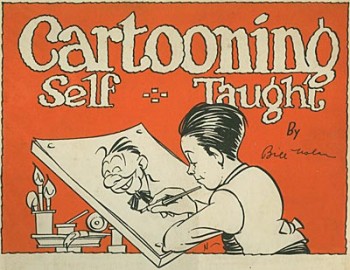
- Sherm Cohen, on his blog, Cartoon Snap has posted a “How To Draw Cartoons” book by Bill Nolan. It originally came from the ASIFA Hollywood Animation Archives, but since all their links are broken, the re-post is welcome.
Bill Nolan, of course, was one of the premiere animators in the early days of animation. He claimed to have invented the cycle in animation. He worked for many studios doing Felix the Cat as well as Krazy Kat. He was one of the forces behind the Oswald the Rabbit series, working for Walter Lantz.
.
In celebration of Pixar’s 25th Anniversary, The New York Times is now taking questions for John Lasseter. In the next week or so Lasseter will answer questions left for him on the Times’ Artbeat blog. So if you want to ask Mr. Lasseter why there aren’t more 2D animated films coming out of Disney or what effect the death of Steve Jobs will have on Pixar’s work or why Cars 2 was such a dud, check in to the Times and leave your question.
.
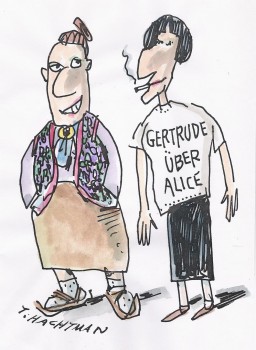
.
- The National Gallery of Portraiture is featuring a show of art about Gertrude Stein. Called Seeing Gertrude Stein: Five Stories, the show features the work of over 100 artists. Tom Hachtman, whose comic strip, Gertrude and Alice. has been an obsession of mine, is one of those artists who contributed to this show. So if you’re in D.C. look for an original piece of art by Tom. (Tomorrow, I’ll post a video of a short short I did of one of Tom’s strips.)
Go here to see one of Tom’s contributions to the exhibit.
The show just opened on Friday and runs through Jan. 22, 2012.
Animation &Independent Animation 25 Aug 2011 07:26 am
Note from Borge
- Mike Barrier had posted a great letter from Borge Ring about David Hand and animation timing. I responded with a short note. I thought I’d written that I wish Hand, who had an enormous knowledge of animation, had said more about the subject in his autobiography. Instead, the book was about his life not about the work he did for his life. Borge Ring misunderstood my badly worded comment on the site, and wrote a letter to me about it. A couple of letters later, things were straightened out, and Borge had written even more wonderful stuff about David Hand’s knowledge. I asked to print that note, and Borge gave permission.
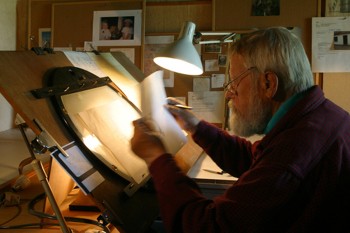 Dave (Hand) was good at rages. They say -When Walt toppled Dave’s well planned day schedule in midmorning, Dave stood at Walt’s office gripping the table with white knuckled hands.blasting Walt.
Dave (Hand) was good at rages. They say -When Walt toppled Dave’s well planned day schedule in midmorning, Dave stood at Walt’s office gripping the table with white knuckled hands.blasting Walt.
Disney later reminisced, “He didn’t know that I never loved him more than at those moments because he cared”
John Canemaker is bound to have Dave’s Cookham lectures – One of them deals specifically with exposure lengths.
I remember a remark:
“6 frames is a hold – 4 frames is neither hay nor grass.”
He never mentions 3 frames.
Preston Blair puts in 3s in the endscene of “Dance of the Hour ” – Croc twirling Hippo, but you don’t notice they are threes.
On request Dave talked about timing to a beat. (the old Jaxon gambit):
“Disney uses many beats but mostly 12 and 8 – because they are easy to break down into inbtws -”
An 8 beat (metronome on 180) with keys 1 – 9 – gets inbtw 5 in the middle and later 2 and 4 -
A 12 beat (metronome on 120) has 1 – 13 -with 7 in the middle
But Duncan and Littlejohn knew all of this and could have told you if you did not already know.
Dave was not very conversant with music and his musician told him to think in (numbered) bars of four beats each, and gave the following rule of thumb, “Place all strong accents on 1 and on 3 in the bar and you will never get me into trouble”
Dave added “You can place your strong accents wherever you choose as long as it makes sense musically.”
“When lengthening or shortening a passage on your barsheet, never add or subtract less than one beat.”
When adding a foot to the timing he did not rewrite the barsheet.
He cut out one line of a virginal barsheet wrote on it and stuck it on to the rim of the sheet. Therefore you got barsheets with “whimpers” sticking out or empty lanes if you had deleted some beats to shorten a passage.
When the barsheet was final he rewrote the numbers of all bars.
Dave animated a little film one afternoon – working to an 8-beat. He drew 1-9-17 -25-etc in very thin grey lines then added all inbtws thinly, flipped and went over the whole scene straight ahead with a fat black line.
He was fast like lightning though he had not animated since 1934
“How do you choose a director?” I asked
“You take a very good animator who is known for getting along with people.”
The new director doesn’t animate, and after awhile they begin to miss his good footage. “Animation developed by leaps and bounds and
after a year the other animators have passed him in quality.”
“Have any of you any experience in story?”
“Oh yes – Jensen and I storyboarded this guy’s script for a feature.”
“But that isn’t story. That is only continuity And that is easy – that is eh if.
Hand and Geronimi stuck to their pleasant style of timing when shorts directors like Jack Hannah sharpened theirs under influence from certain other studios.
Michael,
All this is memory debris that YOU no longer need – But I know It is a warm feeling to hear the “sound” of Old Gold from someone who was in Walt Disney’s studio when “the things” happened.
Kaj Pindal and Kimball were railway pals
“Ward give me the magic feather on animation.”
“Timing is everything,” was the answer.
greetz
Botge
A three stagger 123 -234 – 345 – when shot on twos makes the character look VERY heavy There is one such in “Robin Hood”
By the way, there’s also a wealth of information in Mike Barrier’s interview with David Hand on Mike’s site.
Animation &Books 09 Jul 2011 07:12 am
Tytla, Celestri, Anik and Eric Larsen
- Mark Sonntag just sent me a model sheet from The Hungry Wolf that he found on auction at Howard Lowery’s. There’s no way to tell if these drawings are by Tytla, but the drawing is beautiful just the same. The inclination to shade in the characters on this film is interesting, though. Many thanks to Mark for sharing.
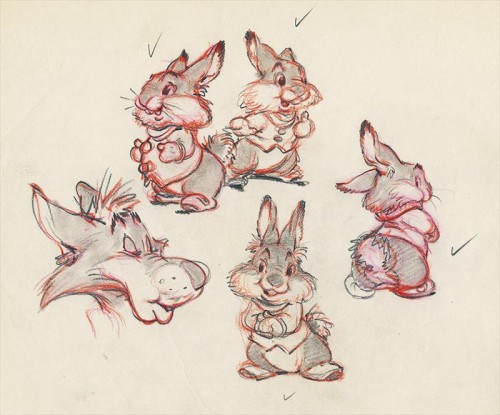
______________________________
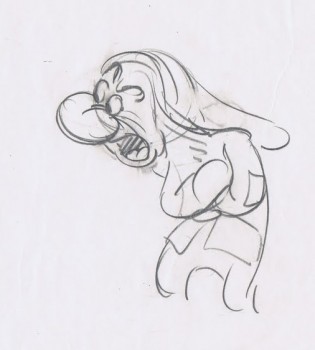 - I am such a fan of Bill Tytla‘s work, I can’t even begin to tell you how much. This week, on his blog, Andreas Deja posted some roughs by Tytla and I couldn’t believe how wonderful some of those drawings are.
- I am such a fan of Bill Tytla‘s work, I can’t even begin to tell you how much. This week, on his blog, Andreas Deja posted some roughs by Tytla and I couldn’t believe how wonderful some of those drawings are.
There’s a series of Grumpy posing in the middle of one of his negative rants, that just sends me. I’ve gone back to the blog at least a dozen times to look at those drawings again and again. The character starts by throwing all of his hostility out to whomever he’s talking to. Then he crosses his arms, with back to the listener. That immediately has him reach out to that person with his entire body, even though his arms stay crossed. It’s such a wonderful mix of emotions so beautifully and graphically presented. All the emotion within Grumpy is out on the floor; he thinks he has nothing to hide and is letting it all out. Thanks to Tytla, we see that Grumpy wants to be like all the others and love Snow White as well. He’s so conflicted and trying so hard not to be honest. This is a brilliant animator at the top of his game.
In the past, I’ve posted quite a few Tytla drawings – most of them loaned to me by John Canemaker. I think in the next week or two I’m going to pull out many of them for a recap. They’re just too great to sit hiding in the morgue of my blog. I want to take another look at them, and maybe share that, again, with you. I hope you’ll indulge my obsession.
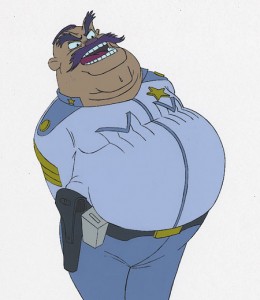 - John Celestri is a very good animator who has been a fan of Tytla’s work since I first met him back in 1977 on Raggedy Ann & Andy. John was in the NY Assistant pool that I supervised, and he was a talent to reckon with. Now, John has a new blog that is starting to take shape. It’s like many animator/director blogs in that it’s built around his work in the industry, and there’s a lot of experience for him to draw on. After he left Raggedy Ann, John moved onto Tubby the TUba at NYIT, then Nelvana to work on Rock & Rule. From there he worked on many features in LA, some with Richard Rich‘s studio for Nest Animation. In every step forward, John’s animation kept getting stronger. Now he has his own studio in Kentucky.
- John Celestri is a very good animator who has been a fan of Tytla’s work since I first met him back in 1977 on Raggedy Ann & Andy. John was in the NY Assistant pool that I supervised, and he was a talent to reckon with. Now, John has a new blog that is starting to take shape. It’s like many animator/director blogs in that it’s built around his work in the industry, and there’s a lot of experience for him to draw on. After he left Raggedy Ann, John moved onto Tubby the TUba at NYIT, then Nelvana to work on Rock & Rule. From there he worked on many features in LA, some with Richard Rich‘s studio for Nest Animation. In every step forward, John’s animation kept getting stronger. Now he has his own studio in Kentucky.
The blog, at present, uses John’s own work to show basic animation techniques and script writing problems. It’s growing up into something quite interesting, and I suggest you check it out, if you haven’t already.
By the way, I love that John has pursued a completely non-animation, secondary path in his life. He has also authored quite a few mystery novels with his wife, Cathie. (Their joint site is called CathieJohn.)
- Also worth visiting is the studio site for Dancing Line Productions. This is the animation company of Anik Rosenblum, a Vancouver, Canada animator who brings a lot of grace and lyricism to the animation he’s been doing for some beautiful spots. There are many examples of his work on the site, and you should take a look at some of it.
Below is an animated piece called “The Autumnal Walk” which gives a good idea of Anik’s work.
The Autumnal Walk
This is one of my favorite pages of Dancing Line’s site. It answers the question, “Why hire us?” Anik has a good, sweet sense of humor. More power to him; I hope his company is successful.
- I just read an interview with Eric Larsen in Don Peri‘s book, Working with Walt. Something Eric said caught me and I thought it would be good to quote him:
- When I came into this business, Frank [Thomas] and Ollie [Johnston] and Marc Davis and Ward Kimball and John Lounsbery all came about the same time. Hal King and a few more came then, too. There was a group of us who developed, and Walt started putting a certain’ amount of responsibility on us in a way. But we came through what we called me unit system: each one of us came up through a very strong animator. These are the men I spoke of a little while ago when I said that here were such great talents and yet they opened up their arms to you to let you have everything they had: Ham Luske, Norm Ferguson, Bill Roberts, Wilfred Jackson, Ben Sharpsteen, Freddy Moore, and then just a little bit later Bill Tytla. Good gosh, what more could you ask for! We came up under those men, being taught, you might say, with them looking over our shoulders. A number of years ago, we dissolved the unit system. Don’t ask me why because I can’t answer. It’s the biggest mistake we made. Now we are trying to set up units again. Like on Bambi, I had ten animators plus all their assistants
working with me. I spent most of my time up here in this room and then would go down and animate at night. But you could keep control of certain things. You learn by working with somebody who has gone I tough the mill. But you’re always learning. There’s no such thing as I graduation in an animation class.
Basically, Eric Larsen is saying that only by our working together can we advance the art of Animation. That’s true. But I wonder if we do that anymore. I wonder if we’re open to each other to try to help out. I hope so. I hope all these new sites, such as John Celestri’s site, help to impart some tidbit of knowledge to someone coming up. It’d be great if it does.
Animation &Animation Artifacts &Commentary 12 Mar 2011 08:37 am
Interviews
- On his website, Michael Barrier has been offering some of the many interviews he and Milt Gray recorded in preparation for his seminal animation history book, Hollywood Cartoons.
Two of these interviews have recently surfaced: Robert McKimson and John Hubley. Something comes across in these two interviews, something that doesn’t quite make it to the history books that try to include all the facts and figures, statements and theories. Personality is what is evident in these interviews.
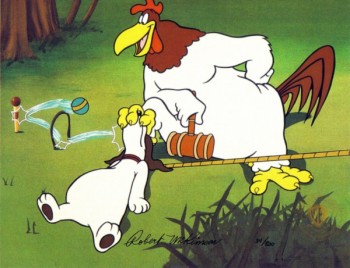 I’d read about Robert McKimson for years, but I never felt much about him. To be honest, I wasn’t a big fan of the films he’d directed for Warner Bros. They’ve always seemed a bit overanimated and don’t always take the shortest route to the gags. I’ve felt a flatness in these films, something even Friz Freleng’s films don’t have. There’s a tightness to Friz’ cartoons, a tightness that shows off the director’s mastery of timing.
I’d read about Robert McKimson for years, but I never felt much about him. To be honest, I wasn’t a big fan of the films he’d directed for Warner Bros. They’ve always seemed a bit overanimated and don’t always take the shortest route to the gags. I’ve felt a flatness in these films, something even Friz Freleng’s films don’t have. There’s a tightness to Friz’ cartoons, a tightness that shows off the director’s mastery of timing.
McKimson, to me, did incredibly beautiful artwork in those early model sheets for Bugs Bunny (well displayed on a sidebar piece on Mike’s site.) His animation certainly stood as strong in those shorts directed by Freleng. There was a bit more of a drive to the scenes he animated.
Reading the interview, I found a distinct personality. There was someone who needed to be in control, who had to take charge, yet never made waves when it didn’t happen. He quietly groused about the problem. A curiously complicated person. Suddenly, I felt more about McKimson the man than I had with all I’d read about him in the past. It makes me want to back up and revisit the shorts he’s directed. (Though not the Foghorn Leghorn films; I just flat out don’t like that character.)
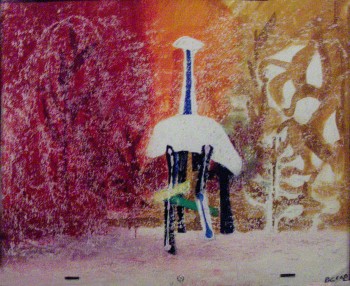 The John Hubley interview is different. I knew Hubley and knew this interview. Mike gave me a copy of it many years ago, and I’ve read it over some half dozen times. However, I can attest to John’s personality being right there.
The John Hubley interview is different. I knew Hubley and knew this interview. Mike gave me a copy of it many years ago, and I’ve read it over some half dozen times. However, I can attest to John’s personality being right there.
You get the feeling that it’s tough for Hubley to spare the allotted hour for the interview. He’s answering all the questions, but you feel like he wants to run to do something else. That was definitely John – always on the run. The only time he seemed at peace, to me, was when he was painting. For animation, when I knew him, that meant rushing out the Bgs for whatever piece we were working on. Given the short amount of time planned for each bit of artwork, it’s amazing how masterfully they all turned out.
The couple of times I made a comment to John about his past work – usually UPA, I was stopped. I remember riding high the day after I’d seen ROOTY TOOT TOOT for the first time. There was no doubt in my mind that I’d seen one of the great animated shorts of my lifetime. So I told John. He just looked at me for a couple of seconds, then turned and exited the room. I don’t know what was behind it, but I knew I wouldn’t get much about his past from him.
It’s amazing, then, to see how much and what detail Mike pulled out of Hubley, and it seems so effortless. In so many words, John tells Mike that he wanted no interference from others over his direction. You’re not quite sure he always fought for it, but there’s no doubt he wanted it. Information, I thought I knew, was clarified in the interview. I was and still am impressed by that information gathering.
Read these two interviews. They’re important. These people are the backbones of our industry, and we can only learn from them.
To that end, you should also know that Mike has quite a few more interviews on his site: Hugh Harman, Joe Grant, Brad Bird, Fess Parker, Frank Tashlin, John McGrew, Art Babbitt and Ward Kimball are all there, as are more. Just scroll down toward the bottom of Mike’s blog, and you’ll find quite a few links to the right of the screen. There’s a lot there on this site.
